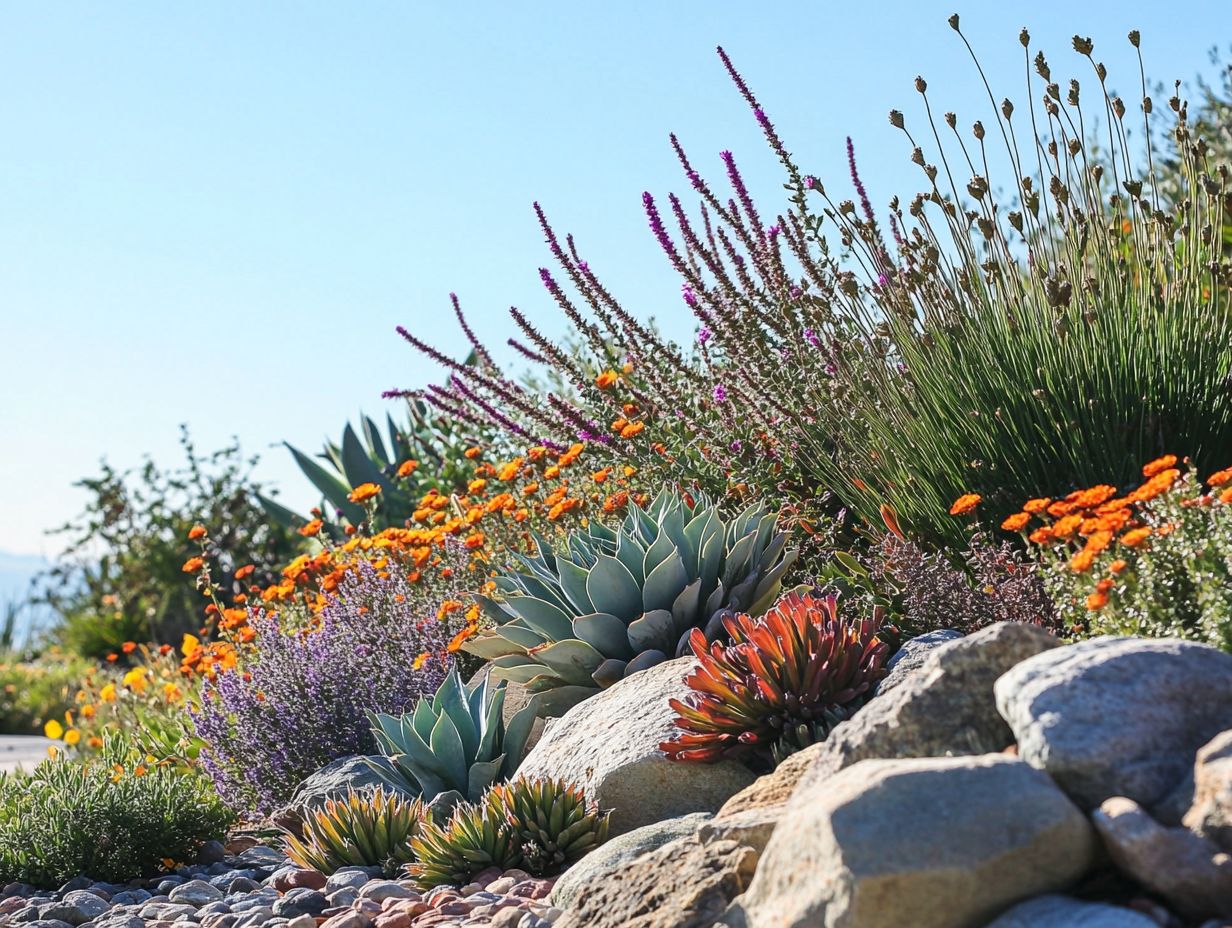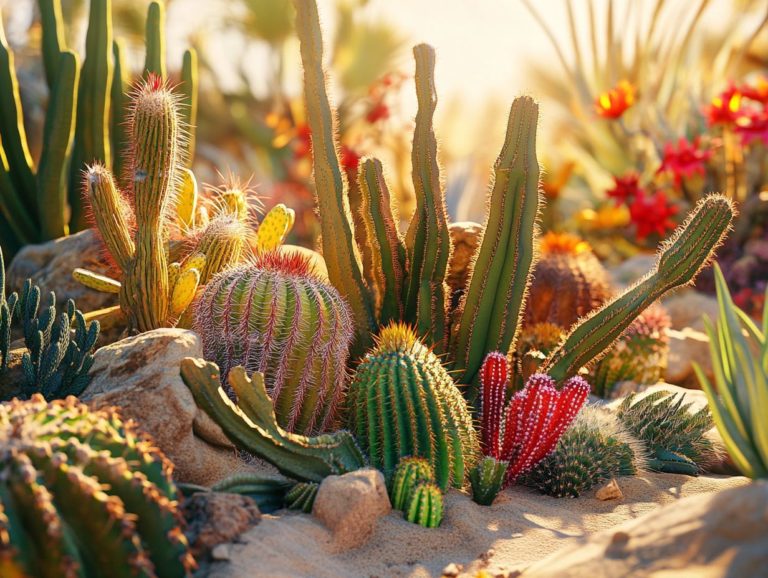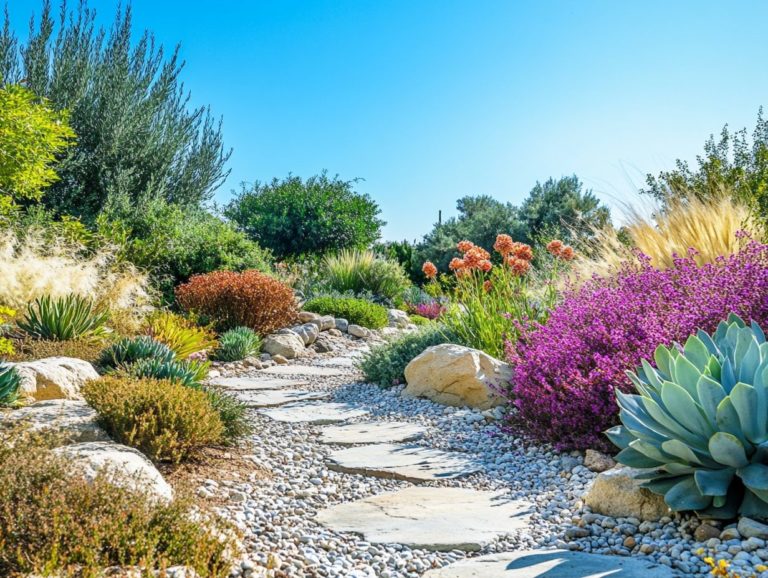Understanding the Benefits of Drought-Tolerant Species
Drought-tolerant species are essential in today s changing climate. They offer sustainable solutions for gardens and landscapes.
These remarkable plants thrive in dry conditions. They provide significant environmental and economic benefits.
By selecting the right drought-tolerant species from native flora to carefully chosen non-natives you can enhance your outdoor space and save water.
In this article, you’ll learn about their unique features, benefits, and how to incorporate them into your landscaping. We’ll also cover common challenges you might face.
Discover how these resilient plants can turn your garden into a low-maintenance oasis!
Contents
- Key Takeaways:
- What are Drought-Tolerant Species?
- Benefits of Using Drought-Tolerant Species
- Types of Drought-Tolerant Species
- How to Incorporate Drought-Tolerant Species in Your Landscaping
- Challenges and Limitations of Drought-Tolerant Species
- Frequently Asked Questions
- What are drought-tolerant species?
- Why should I consider using drought-tolerant species?
- How do drought-tolerant species save water?
- What are the environmental benefits of using drought-tolerant species?
- Can drought-tolerant species be used in any type of landscape?
- Do drought-tolerant species require any special care?
Key Takeaways:

- Drought-tolerant species survive well in dry areas, making them perfect for landscaping in regions with limited water.
- These plants reduce water usage and maintenance costs, benefiting both the environment and your wallet.
- When choosing these plants, think about using native options or alternatives to overcome challenges that may arise.
What are Drought-Tolerant Species?
Drought-tolerant species are crucial for sustainable landscaping, especially in areas facing climate change impacts. These plants are adapted to thrive in dry conditions and need significantly less water than traditional plants.
Incorporating drought-tolerant plants into your garden creates stunning landscapes that enhance visual appeal and help protect the environment. This awareness is vital in regions like Southern California, where water scarcity is a significant concern.
Definition and Characteristics
Drought-tolerant plants are your allies in dry conditions. They showcase impressive adaptations like deep root systems and smaller leaves, allowing them to flourish where others struggle.
These plants are resilient and play a key part in maintaining ecological balance. Their adaptations often include a waxy coating on leaves, which greatly reduces water loss. They also use efficient methods to maximize moisture usage.
For example, the California native Palo Verde tree can endure long dry spells. Lavender flourishes even in poor soil and appreciates well-drained conditions.
To support these plants effectively, healthy soil rich in organic matter is essential. This type of soil helps them access moisture and nutrients, boosting their drought resilience.
Benefits of Using Drought-Tolerant Species
Incorporating drought-tolerant species into your landscaping offers many environmental and economic advantages, making them a vital choice for drought-resistant gardening.
These plants significantly decrease water usage, improve soil health, and support local wildlife, including essential pollinators. Choosing drought-resistant varieties means lower maintenance costs and less frequent irrigation, helping you create a more robust landscape that withstands climate challenges.
Environmental and Economic Benefits

The environmental advantages of incorporating drought-tolerant species into your gardening practices are truly remarkable. Not only do they offer enhanced water conservation, but they also contribute to healthy gardens that nurture diverse wildlife. To learn more, check out why choose drought-resistant plants.
Selecting plants that demand significantly less water helps preserve local ecosystems and reduces your irrigation needs. This allows natural rainfall to support your garden effectively. Such a mindful approach fosters healthier soil and encourages the preservation of native plants, cultivating a vibrant habitat for various species.
Drought-tolerant gardens can cut gardening costs and lower water bills. They re a smart choice for homeowners on a budget!
You will find that maintenance is easy, allowing you to enjoy a stunning landscape with minimal effort and expense reinforcing the long-term viability of low-maintenance gardens.
Types of Drought-Tolerant Species
Drought-tolerant species can be elegantly divided into native and non-native plants, each bringing distinct characteristics to landscaping.
Native plants, like the iconic Joshua Tree and various cacti found in California, flourish with minimal maintenance due to their adaptation to local conditions.
Non-native drought-resistant options, such as Texas Ranger and Sedum, can infuse your garden with striking colors and textures, offering a rich palette to craft your ideal outdoor sanctuary.
Native Plants vs. Non-Native Plants
The distinction between native and non-native plants is crucial when considering their roles in drought-tolerant gardening. Native plants are beautifully adapted to your local conditions and ecosystems.
Choosing plants that thrive in your area enhances the resilience of your landscape and supports local wildlife. Non-native plants can introduce vibrant colors and intriguing textures that may not be found among native selections, making them appealing for unique garden designs.
However, carefully weigh these benefits against potential drawbacks, such as the risk of non-natives turning invasive and disrupting local ecosystems. Understanding how to balance these plant types can lead you to effective water conservation strategies and more sustainable gardening practices.
Examples of Drought-Tolerant Species
Consider these drought-resistant plants for your garden:
- California species, like the striking Palo Verde tree.
- Succulents and lavender, popular garden favorites that showcase remarkable adaptability to dry environments.
These plants not only thrive in arid conditions but also play a significant role in water conservation within landscaping. Take the Agave, for example; with its rosette of thick, fleshy leaves, it effectively stores water, making it ideal for low-maintenance gardens.
Similarly, the Mediterranean herb Rosemary offers aromatic foliage, tolerates poor soil conditions, and attracts beneficial pollinators.
Other recommended options include:
- Resilient Ornamental Grasses, enhancing visual interest and introducing delightful movement to your garden.
- The vibrant Red Yucca, celebrated for its striking red flowers and impressive ability to withstand extreme heat.
By cultivating these plants, you ll find they generally require minimal irrigation, making them especially appealing for eco-conscious gardeners.
Don t wait to enhance your garden s beauty and save water start planting drought-tolerant species today! What drought-tolerant plants will you choose for your garden?
How to Incorporate Drought-Tolerant Species in Your Landscaping

Incorporating drought-tolerant species into your landscaping can elevate your garden into a water-efficient oasis. It will be brimming with sustainable beauty and require minimal maintenance.
To achieve this, select plants that thrive in dry conditions. Explore imaginative planter concepts and ensure your soil is well-prepared to encourage deep root systems.
By choosing both outdoor and indoor plants thoughtfully, you can cultivate resilient landscapes that flourish even in challenging environments. This transformation turns every space into a harmonious blend of aesthetic appeal and environmental responsibility.
Tips for Choosing and Caring for Drought-Tolerant Plants
When selecting and caring for drought-tolerant plants, factor in elements like soil health, how well they grow in your area’s weather, and the unique water-saving features of each species. These considerations also help your garden’s resilience.
For example, understanding your local climate conditions allows you to choose plants that thrive with minimal irrigation, reducing overall water consumption.
Assess the soil type; well-draining or clay soils significantly influence plant growth. It s wise to amend the soil as necessary.
Employ smart watering techniques, such as drip irrigation or rainwater collection, to enhance your water efficiency. By cultivating a diverse array of native plants, you can create habitats that support local ecosystems while enjoying a stunning and low-maintenance garden.
Challenges and Limitations of Drought-Tolerant Species
While drought-tolerant species offer many benefits, they bring their own set of challenges and limitations. Factors like soil types, local climate conditions, and the unique requirements of various drought-resistant plants can significantly influence their success.
By understanding these challenges, you can make informed decisions that boost your chances of cultivating thriving, resilient landscapes even in adversity.
Potential Drawbacks and Solutions
Despite the undeniable perks of drought-tolerant plants, you might encounter potential drawbacks. These include a limited range of colors and textures, particularly during extreme droughts, which can lead to landscapes lacking visual appeal.
While these species thrive with minimal water, their maintenance needs can sometimes be overlooked. For instance, some drought-resistant varieties may require specific soil conditions or occasional pruning to truly flourish.
Consider expanding your options with a wider array of alternatives. Succulents can bring vivid hues and unique shapes to your garden, while native perennials are well-suited to your local climate.
Mixing different plant adaptations with smart water-saving methods can create a stunning, eco-friendly garden. You ll enjoy an outdoor space that beautifully marries aesthetics with practicality.
Frequently Asked Questions

What are drought-tolerant species?
Drought-tolerant species are your go-to plants for thriving gardens with minimal water. They are able to survive and thrive in dry and arid conditions.
Why should I consider using drought-tolerant species?
Drought-tolerant species have many benefits, such as requiring less water, being more resilient to drought and climate change, and understanding the benefits of xeriscaping to support local biodiversity.
How do drought-tolerant species save water?
Drought-tolerant species have evolved to be better at conserving water. They feature deep root systems, waxy coatings, and small leaf sizes that reduce water loss.
Start planning your water-efficient garden today and enjoy its beauty all year round!
What are the environmental benefits of using drought-tolerant species?
Drought-tolerant species reduce water usage and help conserve local water resources.
They also keep the soil healthy and provide habitat for wildlife.
Can drought-tolerant species be used in any type of landscape?
Absolutely! You can use drought-tolerant species in gardens, parks, and urban areas.
Just research which species thrive in your specific location.
Do drought-tolerant species require any special care?
These plants are generally low maintenance.
They need a little extra care in the first year to establish roots, but after that, they can survive with minimal watering.






